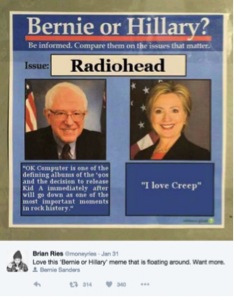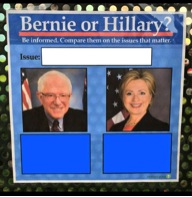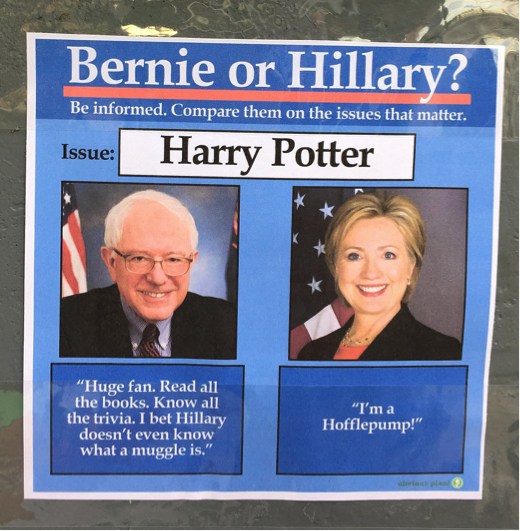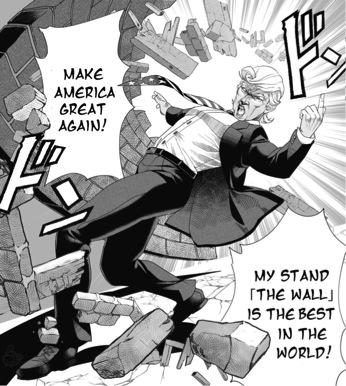Civic Paths Hotspot: Remixing the U.S. Presidential Campaign
/Donald Trump for President? Don’t make me laugh! Well, actually, laughter may be one of the most effective forms of political speech in an election cycle with so many over-sized personalities, so many odd twists of fortune, so many outrageous statements from all the parties involved. We are reminded of an earlier political advertisement from the 1972 U.S. Presidential election where laughing away the opposition turned out to be a key gesture.
Over the past term, the Civic Paths research group has been developing a shared framework for thinking about contemporary politics, one which has been inspired by the groundwork we had done for our recently released book, By Any Media Necessary: The New Youth Activism. Here are a few of the defining traits we’ve been talking about together:
- Activists have always promoted social change by tapping the civic imagination. That is, before you can change the world, you have to imagine what a better world looks like. More and more, young people are using popular culture references as a shared frame of reference for debating the kinds of future they want. This form of the civic imagination tells us what we are fighting for.
- The civic imagination may also require us to envision dystopian alternatives -- worlds gone bad, evil triumphing -- so we know what we are fighting against.
- Activist media is designed to circulate -- it is spreadable -- through informal social networks both on-line and off, and one of the most effective ways to insure circulation is to make people laugh.
- These new forms of activism rely on the mechanisms of participatory culture: young people -- many of whom would not have been politically active otherwise -- are being drawn into engagement via what researchers are calling participatory politics.
- So, one of the ways to bring these insights together is to be attentive of the ways popular culture and politics are remixed into memes which circulate within and sometimes spread beyond participatory culture communities.
These memes can deploy a range of different media, as we will see -- from the tangible to the digital, from images to videos. We are thus seeing a Bernie Sanders-themed musical, modeled upon Hamilton, and Donald Trump as a evil warlord in the world of Game of Thrones, to cite just two examples, of the civic imagination at play.
Sanders ( Bernie Sanders + Hamilton ) from Tabitha Holbert on Vimeo.
We hosted a show and tell session where members of our research group identified examples of grassroots mashups of the political process that were circulating within their own communities. We brought them together for comparison and analysis. And what follows here are short pieces intended to share some of the conversation they engendered. Many of these, as you will see, use parody to express ideas about what is going on out there on the campaign trail and to share what it might mean for the people who will be most impacted by the outcome.
We’ve love to see examples you encounter in your own social networks and especially we would love to see examples of how these same practices may be deployed by conservative groups, given that most of our examples take a more progressive stance. These materials are ephimeral, but significant, in understanding how politics works today. So, we are trying to assemble our own archive for future research and teaching.
**********************************************************
“Participatory Aesthetics” by TJ Billard
hyperakt (hyperakt.com), Brooklyn, NY
 Shawn Hazen (hazencreative.com), Chicago, IL
Shawn Hazen (hazencreative.com), Chicago, IL
Both of these pictures demonstrate the way appropriating the graphic elements--and in particular typeface--of Obama’s campaign allows citizen content producers to contribute to the campaign’s messaging. The first of these pictures is interesting for two reasons: it uses Gotham (the typeface used by Obama’s campaign) to tie the image into the campaign’s official content, and it uses the famous picture of Barack and Michelle as well; but it also riffs on Shepard Fairey’s HOPE poster, engaging simultaneously with the official campaign content, as well as other citizen-created content. The second image more simply reflects the appropriation of the campaign’s official typeface and color palette, blurring the lines between citizen-originated content and campaign-originated content.
**********************************************************
Mark America Great Again by Yomna Elsayed
We have witnessed some extreme, sometimes “surreal”, political rhetoric this election season. But, many times the response to surreal rhetoric such as that of Trump or Cruz, was equally surreal, even hilarious. After all jokes are a temporary displacement from the control of the conscious to the arbitrariness of the subconscious[1]. Hence it was not surprising to see comedy flourish in atmospheres of fear and racism. Lawrence Levine in his Black culture and black consciousness records how slaves used humor for a variety of purposes from self-control, by releasing a wide range of inhibiting energies and feelings, to subversion and control of the social situation, by using the majority’s stereotypes in their humor “in order to rob them of their power to hurt and humiliate”. Jewish humor was also utilized as a “political weapon and as a provocative form of entertainment during (and in response to) an extreme state of a culture under threat of extermination”[2]. In either case, one can say that humor was a response to a situation that goes beyond human reason, one that deals with primitive human feelings of hate and fear. Humor certainly entertains, but it also works to challenge our perceptions by inviting us to reconsider taken-for-granted assumptions in a different light, bringing about cognitive dissonance to our clearly defined unproblematic understanding of the world. It does so, without necessarily incurring our resistance, but rather clandestinely encouraging us to laugh at ourselves in the company of others. Ultimately, notes Levine, laughter is a social phenomenon.
At a time of conflict, our response to jokes depends not only on how clever they are, but on our relation to their subjects and butts as well. Therefore, the more we identify with a leader the less we are going to enjoy jokes at his or her expense[3]. Hence jokes demarcate by defining those who share the joke as ‘we’, and those who don’t, as the ‘other’. But to muster the will to laugh at someone is to exert power on oneself and others; a power to overcome one’s helplessness in response to what appears to be a ridiculous situation on one hand, and to turn the tables and laugh at those in power (a temporary exchange of places) on the other. In colloquial Egyptian, if someone successfully ridicules someone we’d say, “He has left a mark on them” and that’s precisely what humor does. Humor could be a temporary release of energy, but it is also one that leaves visible marks on what once seemed to be unconquerable.
This election season, Trump has been the subject of many comedy shows from SNL sketches to the daily show’s satirical commentary. His outrageous comments regarding minorities, coupled with his unrestrained trolling, made him an amusing figure to media pundits and comedians alike. Other less professional ones, focused on Trump supporters by attending Trump rallies and recording their reactions to seeing an unlikely face. Though others suggested that this maybe an opportunity to reach out to Trump supporters (who “identified with Trump for a reason”) rather than simply ridicule them. However, of the funny videos circulated around Trump, “Your Drunk Neighbor: Trump” stands out to me.
“Your Drunk Neighbor: Donald Trump” has so far garnered over 1 million views since its release in October 2015. The video appeal lay in its use of incongruity, and surprise to draw laughter from viewers. This was one of the few sketches that removed Trump from the presidential candidate podium to a more familiar setting and character: a drunk neighbor. By juxtaposing Donald Trump speeches with the familiar image or frame of “your drunk neighbor”, it exposes the irrationality and lack of seriousness in choosing Trump as a presidential candidate: much like choosing your drunk neighbor for president. However, this video would not have been as successful if it did not build its humor on grounds of a non-threatening familiar situation1, such as that of drinking beer over your porch’s rocking chair in a warm summer afternoon. Furthermore, a recent survey by the university of Quinnipiac, showed that Trump’s name had a polarizing effect “on Americans attitudes about general statements and policies” advocated by the presidential candidate. With such polarization, humorous videos like “Your Drunk Neighbor”, can take away the edge of political criticism, inviting viewers, supporters or not, to assess their position in a non-threatening light situation of both entertainment and release. For Trump himself, one can say, at the very least, it “leaves a mark”.
[1] Douglas, M. (1968). The social control of cognition: Some factors in joke perception. Man 3(3), 361-376.
[2] Kaplan, L. (2009). In Jenkins, H., McPherson, T., & Shattuc, J. (Eds.), Hop on Pop: The politics and pleasure of popular culture. Duke University Press Books.
[3] Lewis, P. (2006). “Divided We Laugh”. In Cracking up: American humor in a time of conflict. University of Chicago Press, pp 1-20.
**********************************************************
Collection of Election-related folk art for sale on Etsy by Samantha Close
From left to right:
“Ted Cruz Republican Leading the Fight” from ConservativeArt
“Feel the Laser Bern” from DanSchaubDesigns
“Women for Hillary jewelry” from slrfreespiritjewelry
“Donald Trump doll” from TobeyTimeCrochet
The stuff of politics is never supposed to be important. Signs get taken down, pamphlets get thrown away, and people move on to laws, policies, and budget disputes. In traditional thinking, this arena of financial appropriations and negotiating which and what laws make it on the books is the important political “stuff,” the way you see what the candidates are really made of. There is a lot of truth to this.
But, as Stephen Duncombe (2007) points out, this is also a highly intellectualized, rationalized, and cerebral way of understanding politics that misses out on much of what inspires and motivates people to take part. The craft and folk art objects related to candidates in the 2016 presidential election that are pictured here suggest a different, more affective and emotional relationship to politics that requires an outlet in durable, material stuff that will remain long after the candidates are selected and the election concluded.
The contemporary political climate in the United States, as many of my comrades are pointing out in this discussion, is often highly cynical. Political talk is heavily inflected by irony, humor, and sarcasm—to the extent that, at first glance, many might wonder if the folk art pictured here isn’t taking the piss rather than being sincere. It’s an elitist, urban—Duncombe might say traditional leftist—sensibility that sees a hagiographic woodcut or hand-penciled (and sharpie-d) portrait as parody rather than proud declaration of identification and admiration (Sweeney, 1997).
Particularly in communication and cultural studies scholarship, this kind of highly invested affective relationship is more familiar in the realm of fandom—we would have little pause in characterizing a Harry Potter amigurumi doll as made out of love. It is past time that we take as much care and bring as much nuance to analyzing how identification works on an emotional level in the domain of political communication as we do in the domain of popular communication (for one example of such analysis, see Liana Gamber-Thompson (2016) on Libertarian fandom).
Such a politics is at once more and less empowering for the average citizen and very different from how we were taught that our political system works in sixth-grade civics. It much more closely resembles the Christian “What Would Jesus Do?” philosophy, oriented towards the impact of identification and belief in daily life rather than in official spheres (Jackson, 2006). This is in line with the religious overtones and symbolism of much candidate-related folk art. This election folk art suggests a different interpretation of the ubiquitous question “does my vote matter?” It matters because it matters to the voter, not necessarily for them.
References Duncombe, S. (2007). Dream: re-imagining progressive politics in an age of fantasy. New York: New Press ; Distributed by W.W. Norton. Jackson, G. S. (2006). “What Would Jesus Do?”: Practical Christianity, Social Gospel Realism, and the Homiletic Novel. PMLA, 121(3), 641–661. Jenkins, H., Shresthova, S., Gamber-Thompson, L., Kligler-Vilenchik, N., & Zimmerman, A. M. (2016). By any media necessary: the new activism of American youth. New York: New York University Press. Sweeney, G. (1997). The King of White Trash Culture: Elvis Presley and the Aesthetics of Excess. In M. Wray & A. Newitz (Eds.), White trash: race and class in America (pp. 249–266). New York: Routledge.
**********************************************************
It’s Over 1000! by Rogelio Lopez
I came across this on my Facebook newsfeed and thought it was funny/interesting. The piece is by artist CR Bergen and was apparently posted to his Tumblr on April 5, 2016. The illustration re-imagines a scene from the Dragon Ball Z animated series, where the characters Vegeta and Nappa sense the protagonist Goku’s increase in power as he becomes enraged. The scene became a widely circulated meme on its own, due to the hilarious voiceover for the phrase “It’s over 9000!” Bergen uses the scene to interpret the unexpected populist rise of Bernie Sanders, comparing him to DBZ protagonist Goku. At the same time, Hillary Clinton is compared to Vegeta, an antagonist of the series. The image clearly provides a comical critique of Clinton and the DNC by associating her to imperialist villains from DBZ, while showing support for Sanders. The “Feel the Bern” pin on Sander’s characters while he is engulfed in blue flame is a nice touch.
**********************************************************
Hashtag #HillarySoQualified by Limor Shifman
#HillarySoQualified she can only win by buying votes
The story of this hashtag, which started as a pro-Hillary response to Bernie Sanders’ assertion that Clinton is not “qualified” to be president and was quickly hijacked by Sanders’ supporters, is particularly revealing. What it seems to expose (beyond Clinton's inferiority in this scene) is that some forms, or templates, of participatory “positive” commentary are almost by default inviting cynical responses. Hashtags which are cynical, or ironic, to begin with are thus more likely to maintain their original agenda (e.g. ##distractinglysexy, #benCarsonWikipedia).
**********************************************************
Donald Trump and Mean Girls by Chloe Yuqing Jiang
I came across this video shared by a friend on my own Facebook news feed last week.
Being one of the biggest fans of Mean Girls, I found this video extremely interesting and captivating (probably given the fact that I could memorize the whole script by heart). The video “stars” Donald Trump as Cady Heron and incorporates some of the key arguments Donald Trump has been making. It also highlights these arguments which makes it amusing to watch. The video was posted on April 3, 2016 under the account TheCrazyGorilla, a YouTube channel made by two guys who produce funny videos weekly. With 185,456 views on YouTube, I think it is a smart idea to combine politics and entertainment to raise more awareness on election, especially for those who are less tuned in with political issues. This video might inspire more young people to create more relatable content like this and share the message through social media platforms to reach more audiences.
**********************************************************
Bernie of Hillary Meme by Michelle C. Forelle
This is a meme I’ve been seeing all over my Tumblr dashboard. According to Know Your Meme, the meme originated from a 12-image post simultaneously put up on Tumblr and Reddit on January 28, 2016 by user ObviousPlant, with the caption “Left in the streets of Los Angeles”. It is clearly designed for people to mess with, with big text fields that are very easily Photoshopped. What’s particularly interesting about it is that the blank template could be used by supporters of either candidate - when it’s blank, there is no indication who is favored. Interesting note that I found on the KYM entry for this -- there is a Facebook group, now with over 436,000 members, called “Bernie Sanders’ Dank Meme Stash”.
**********************************************************
#Time2Escalate: A movement of movements by Emilia Yang
The Black Lives Matter organization, the anti-deportation campaign Mijente (#Not1More), and the Grassroots Global Justice Alliance (which works on global issues including climate change) promoted a call with a hashtag first popularized by the white-ally network Standing Up for Racial Justice: #Time2Escalate to agitate Drumpf through the GOP's summer convention and beyond in order for white allies to join and take a stance.
Anti-Trump protesters aren't trying to change anyone's mind. Here's their strategy. (Vox explainers)
The action and the push towards escalation is based on some of these assumptions:
http://us3.campaign-archive1.com/?u=ccd613dafe6681329ae72b256&id=e90f9c901c&e=5649f5c71f
http://mic.com/articles/139615/wisconsin-s-white-people-want-to-stop-donald-trump-too#.9hiDklRz3
Bernie is almost as cute as Mujica <3
http://thingstolovefor.tumblr.com/post/142065321382/every-time-i-see-something-like-this-im-on-the
**********************************************************
Trump's Bizarre Election by Yining Zhou
I found this image on my facebook stream, repost by several friends whose interest lies in the intersection between manga and politics. Trump was put in a scene from Jojo's Bizarre Adventure (JJBA) series. In its third series, Stardust Crusaders, JJBA introduced the concept of supernatural power called "Stands", which was the semi-physical manifestation of the user's psychic powers resembles a spiritual familiar standing next to them.
On one hand, the picture offers a critique, pointing out Trump over emphasises "the stance" all the time. On the other hand, it is hilarious smart to juxtapose Trump election with Jojo's adventure, implying that both of them are kind of radically idealistic and bizarre.









